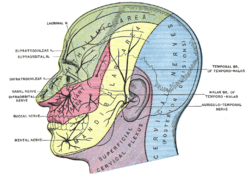Structure and Course
- The infraorbital nerve is a branch of the maxillary nerve, which is a branch of the trigeminal nerve.
- It arises from the maxillary nerve in the pterygopalatine fossa.
- It travels through the inferior orbital fissure to enter the orbit.
- It runs along the floor of the orbit in the infraorbital groove.
- Within the infraorbital canal, it has three branches: posterior superior alveolar nerve, middle superior alveolar nerve, and anterior superior alveolar nerve.
- After traversing the canal, it emerges onto the anterior surface of the maxilla through the infraorbital foramen.
Branches
- Within the infraorbital canal, the nerve has three branches: posterior superior alveolar nerve, middle superior alveolar nerve, and anterior superior alveolar nerve.
- After exiting the infraorbital foramen, it has palpebral branches.
- After exiting the infraorbital foramen, it has nasal branches.
- After exiting the infraorbital foramen, it has superior labial branches.
- The palpebral branches supply the skin of the lower eyelid, the nasal branches supply the skin of the side of the nose and nasal septum, and the superior labial branches supply the skin of the anterior cheek and upper lip.
Relations
- Along its course, the infraorbital nerve is accompanied by the infraorbital artery and vein.
Distribution
- The infraorbital nerve provides sensory innervation to the skin of the lower eyelid, side of the nose, nasal septum, anterior cheek, and part of the upper lip.
- It does not provide motor supply to any muscles.
Summary
- The infraorbital nerve is a branch of the maxillary nerve and travels through the inferior orbital fissure to enter the orbit.
- Within the infraorbital canal, it has three branches: posterior superior alveolar nerve, middle superior alveolar nerve, and anterior superior alveolar nerve.
- After exiting the infraorbital foramen, it has palpebral, nasal, and superior labial branches.
- It is accompanied by the infraorbital artery and vein along its course.
- The infraorbital nerve provides sensory innervation to various areas of the face but does not supply any muscles.
The infraorbital nerve is a branch of the maxillary nerve (itself a branch of the trigeminal nerve (CN V)). It arises in the pterygopalatine fossa. It passes through the inferior orbital fissure to enter the orbit. It travels through the orbit, then enters and traverses the infraorbital canal, exiting the canal at the infraorbital foramen to reach the face. It provides sensory innervation to the skin and mucous membranes around the middle of the face.
| Infraorbital nerve | |
|---|---|
 Left orbicularis oculi, seen from behind. (Infraorbital nerve labeled at lower left.) | |
 Sensory areas of the head, showing the general distribution of the three divisions of the fifth nerve. (Infraorbital nerve labeled at center left, at the nose.) | |
| Details | |
| From | maxillary nerve |
| To | posterior superior alveolar nerve, middle superior alveolar nerve, anterior superior alveolar nerve, palpebral branches, nasal branches, superior labial branches |
| Identifiers | |
| Latin | Nervus infraorbitalis |
| TA98 | A14.2.01.059 |
| TA2 | 6239 |
| FMA | 52978 |
| Anatomical terms of neuroanatomy | |
infraorbital nerve (plural infraorbital nerves)